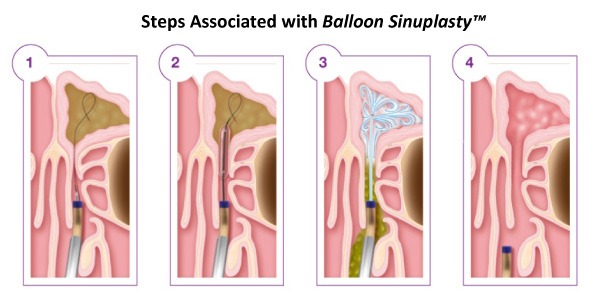Balloon Sinuplasty is a breakthrough procedure that relieves the pain and pressure associated with chronic sinusitis. It is used by surgeons to safely and effectively treat chronic sinusitis patients who are not responding well to medications such as antibiotics, nasal steroids, or over‐the‐counter (OTC) drugs, and are seeking relief from uncomfortable and painful sinusitis symptoms.
Similar to how angioplasty uses balloons to open blocked arteries, Balloon Sinuplasty, a system of FDA‐cleared, catheter‐based instruments, opens blocked sinuses.
The procedure is less invasive than traditional sinus surgery. It allows most patients to return to normal activities quickly.1
With Balloon Sinuplasty, a specially‐designed catheter is inserted into the nose to reach the inflamed sinus cavity. A small balloon is slowly inflated, which widens and restructures the walls of the sinus passage, helping to drain mucus from the blocked sinus and restore normal sinus drainage without cutting and with minimal bleeding. This approach also preserves the natural structure of the sinuses.

Published clinical data shows that Balloon Sinuplasty provides symptom relief for the majority of patients:
In the operating room:
- A multi‐center study of 1,036 patients who had Balloon Sinuplasty reported that sinus symptoms improved in 95 percent of patients at an average follow‐up period of 9 months.2
- Another multi‐center study followed 65 patients who had Balloon Sinuplasty and reported clinically and statistically significant improvement in patient symptoms out to two years.3
In the office:
- Ninety‐five percent of patients who have had Balloon Sinuplasty say they would have it again.4
Balloon Sinuplasty is performed under general anesthesia in an outpatient setting; however, some surgeons are choosing to treat certain patients in their office under local anesthesia. The reported complication rate for Balloon Sinuplasty is low.
Patients who suffer from chronic sinusitis and are not responding well to medications may benefit from seeing an Ear, Nose, and Throat (ENT) physician who performs Balloon Sinuplasty to determine if the procedure is right for them. Most insurance companies and Medicare provide coverage for Balloon Sinuplasty.
Balloon Sinuplasty has been used to treat more than 160,000 patients since receiving FDA clearance.
For more information about Balloon Sinuplasty, visit www.balloonsinuplasty.com
Balloon Sinuplasty is intended for use by or under the direction of a doctor. There are associated risks, including tissue and mucosal trauma, infection, or possible optic injury. Interested individuals should speak with their doctor about the risks and benefits and to determine whether Balloon Sinuplasty is right for them.
Sources
1 Wynn, R. and Vaughan, W. “Post‐op Pain after FESS with BST” poster AAO 2006.
2 Levine et al, “Multicenter Registry of Balloon Catheter Sinusotomy Outcomes for 1,036 Patients.”Annals of Otology, Rhinology & Laryngology, 117(4):263‐270, 2008.
3 Weiss et al. “Long‐term outcome analysis of balloon catheter sinusotomy: Two‐year follow‐up.” Otolaryngology‐Head and Neck Surgery (2008) 139, S38‐S46.
4 ORIOS I, office‐based dilation, Data on file #006.
